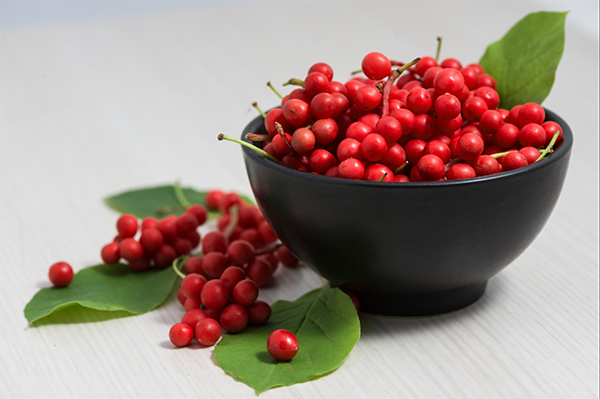Flavor is important – especially if you want to enjoy your food! But can using different flavors also have health benefits? Many ancient traditions and philosophies say “YES.”
One of these is Traditional Chinese Medicine (“TCM”), where food is divided into five flavors, each having unique properties and benefits. Here’s a little exploration into the five flavors and how you might be able to use them to enhance your diet.
Intro to TCM Diet Therapy
Food is viewed and used as medicine in TCM. In fact, many Chinese herbal formulas actually contain common household foods such as ginger, dates, and cinnamon. While nutritional value of foods is important, the rich flavors and natures of herbs and food also play an essential role and are not only for pleasure.
Chinese Medicine theory recognizes five (sometimes six) flavors and their unique interactions with the body’s systems: sweet, bitter, sour, acrid, and salty, with the addition of bland. Each flavor has a therapeutic action by guiding the movement and function of the herb or food to a particular organ and channel system.
Five Element theory in Chinese medicine establishes relationships between the organs, flavors, and other factors such as seasons, emotions, and colors.
The Five Flavors
-
Acrid/Spicy/Pungent
Acrid flavor guides to the lungs and large intestine, supporting the respiratory system. The energetics of this flavor increases circulation of the blood and the body’s energy. It also disperses energy in an outward direction and releases the exterior.
Have you ever eaten something spicy and broken a sweat? That’s a common experience of this dispersing outward direction of energy.
Because of these actions, this flavor of herbs and foods may help to protect you during sniffle season. Adding acrid foods or herbs to your meals during this time of year may support healthy respiratory function. Research shows that ginger may have anti-viral effects in the body. (1)
Examples of pungent foods are scallions, ginger, garlic, radish, turnip, cayenne, fennel, and cinnamon.

-
Sweet
Sweet flavor has the property of tonifying and strengthening the digestive function. In Chinese medicine, the sweet flavor correlates to the spleen, stomach, and pancreas. It is one of the most common flavors and is present in many foods.
Foods identified as sweet are simple foods that are nourishing and easy to digest. Sweet foods and herbs have a harmonizing action on the body’s energy. While there is such a thing as overly sweet (think refined sugar in cakes and cookies), many fruits and vegetables contain a more subtle and balanced sweetness that can support digestive function.
Avoid overindulgence in refined sweets and opt for sweet flavored foods such as rice, beans, dates, lentils, carrots, onions, some meats, fruits, and squash.
-
Bitter
Bitter flavor guides to the heart and has a downward, draining, drying, and clearing action. Bitter foods are often also cool and clear heat from the body. Because of this heat clearing property, they are often recommended in cases of inflammation.
Examples of bitter foods are coffee, chicory root, dark leafy greens such as kale, dandelion greens, collard greens, echinacea, valerian, and chamomile.
-
Sour
Sour foods interact with the liver and gallbladder. Their action is astringent and absorptive to hold and contain fluids and energy. The direction of the movement of energy is inward. The sour taste may counteract the effects of greasy or fatty foods and is often used to assist certain types of digestion issues. Sour foods are often recommended for incontinence and diarrhea.
Examples of sour tasting foods are vinegar, lemons, lime, pickles, sauerkraut, and fermented foods.
-
Salty
Salty flavors guide to the kidney and bladder. The function of this taste helps to regulate mineral and fluid balance. Its actions according to Chinese Medicine theory are to direct energy downward and soften hardness, dissolving masses or nodules, and promoting bowel movements.
Examples of salty foods are seaweed, kelp, miso, soy sauce, and pickles.
Bland flavor doesn’t have a particular affinity for an organ system. In Chinese medicine theory it promotes urination and fluid metabolism.
How to Use the Five Flavors
Besides creating a variety of tastes, incorporating each of the different flavors may help to correct imbalances, supporting healthy functioning of the body’s organ systems. Since consuming the flavors corresponding to a particular organ may support that organ’s function, it can be useful to incorporate a variety of the five flavors into each meal.
Balance is key when it comes to diet and working with the five flavors! Too much or not enough of one flavor may lead to imbalance. Aim to vary your intake by incorporating varieties of herbs, organic fruits and vegetables, as well as organic grass-fed meats and wild caught fish.
Herbs and foods can have more than one flavor and most of them do! In Chinese Herbal theory Schisandra berry (Wu Wei Zi), known for its antioxidant effects in modern nutritional therapy and considered an adaptogen, includes all five flavors! (2)

What About Cravings?
Sometimes particular organ systems may need more support than others. When there is imbalance in the body, the system may send signals through cravings. We all get them, and in Chinese medicine, cravings are used as a diagnostic tool.
To support balance, emphasize more of the flavor that you are craving. Think of a craving as your body communicating to you with a subtle hint. It’s useful to tune into your body’s desires so you can better support your health!
Eating with the Seasons
Another way to incorporate the five flavors is to emphasize particular flavors during certain seasons. According to this theory, acrid/spicy/pungent foods are related to fall, sour to the spring, bitter taste in the summer, salty in the winter, and sweet for late summer but is best to use in all seasons.
Try cooking seasonally by adding more foods and herbs that correspond to that particular time of year. In Chinese Medicine theory, the approach is to match the energetic actions of the food and herbs to best support the needs of the body throughout the year.
Get creative and get cooking! The five flavors are a tasty way to support your most healthy, radiant self. As with any nutritional changes, always notify your health care provider before making any dietary adjustments.







